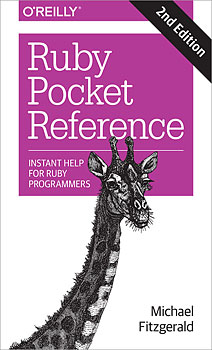"blocks" entries

Blocks in Ruby
A fundamental Ruby idiom explained.
When we talk about blocks in Ruby, we’re not usually talking about code blocks — or blocks of statements — as we might with other languages. We’re talking about a special syntax in Ruby, and one of its idioms. I’ll be discussing blocks in this article, plus a little about procs and lambdas.
Ruby’s blocks are always associated with methods, which are sets of recallable procedures. Blocks can’t get along very well by themselves. They are dependent on methods, which normally feed data to them. Without that data, a block can’t do anything useful. It needs a parent to look after it.
Blocks are anonymous and are sometimes referred to as nameless functions. Blocks are like methods within another method that grab data from an enclosing method. If all this is unfamiliar to you, it may not make sense. Keep reading and I’ll do my best to clear things up for you.

Why Ruby blocks exist, part III
Never forget to clean up again!
Previous posts in this series used Ruby blocks to iterate over the items in a collection. We’re going to wrap up by showing a very different side of blocks – resource allocation and cleanup.
Close the door!
Here we have a Ruby class representing a refrigerator. Prior to accessing a refrigerator object’s contents via its `contents` method, you have to call its `open` method to open the door. (Sensible enough.) Read more…

Why Ruby blocks exist, part II
Putting return values to work
Last time, we showed you how to use Ruby’s each method with blocks to process the elements of an array, and how it can save you a lot of repetitive looping code. That was just an introduction, though.
In our previous examples, the block was a final destination. We passed data into blocks, but it never came back out (unless we printed it to the screen). Today we’re going to look at block return values, and how your methods can use them to manipulate your data in even more powerful ways.
Before we move on…
We should mention that there are two syntaxes for blocks in Ruby. In the earlier post, we used the do ... end syntax:
my_method(my_argument) do |my_parameter| # Code here end
With blocks that fit on one code line, it’s often preferred (though not required) to use the alternate curly-brace syntax for blocks:
my_method(my_argument) {|my_parameter| # Code here }
We’ll be using the curly-brace style of blocks today.

Why Ruby blocks exist
Exploring Ruby's "each" method
It seems like more and more languages these days are getting support for closures in one form or another. (Even Java is getting in on the game, finally.) Ruby has had closure-like structures called blocks since its early days, though, and they’re central to the language. Used properly, they can reduce repetition and even make coding less error-prone. Understanding blocks can give you some great ideas to take home to your language of choice. (Or, who knows? Maybe you’ll decide you like coding in Ruby better!)
Today, we’re going to show you just one of the many Ruby methods that use blocks: each. We’ll show you some repetitive code that, in most languages, would be hard to refactor. But using each, we’ll quickly wring that repetition out.

Upward Mobility: Dump Those iOS Delegates
Blocks are the way to go
Because so much of iOS programming involves the delegate pattern (the UITableViewDelegate being a prime example), it’s natural that when programmers are developing their own classes that need to be able to asynchronously call back to a client class, they would use the delegate pattern as well. The problem with delegates is that they are fairly inflexible. For example, let’s consider the following (totally inappropriate) use of a delegate:
@protocol MultiplierDelegate <NSObject>
-(void) handleResult:(float) result;
@end
@interface Multiplier : NSObject
-(void) multiply:(float) v1 and:(float) v2
delegate:(NSObject<MultiplierDelegate> *) delegate;
@end
#import "Multiplier.h"
@implementation Multiplier
(void) multiply:(float) v1 and:(float) v2
delegate:(NSObject<MultiplierDelegate> *) delegate {
[delegate handleResult:v1 * v2];
}
@end
The problem lies when you need to call this method twice from the same class.
#import "Multiplier.h"
@interface MultiplierCallee : NSObject<MultiplierDelegate>
@end
@implementation MultiplierCallee
-(void) example {
Multiplier *mult = [Multiplier new];
[mult multiply:3.2 and:23.3 delegate:self];
}
-(void) handleResult:(float)result {
NSLog(@"Result is %f", result);
}
@end
So far, so good, but what happens if you want to have a second method in the same class call multiply? You can only have a single delegate method, so you have to start jumping through hoops to let the delegate method know where to put the resulting value.
The modern solution to this is to use blocks. People tend to shy away from them, because the syntax is a bit arcane and un-Objective-C, but they are incredibly powerful, and Apple has signaled that they are the future, by starting to use them heavily in areas such as animation.
Read more…
